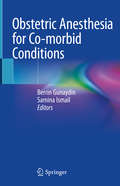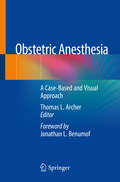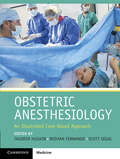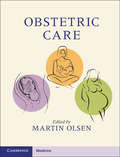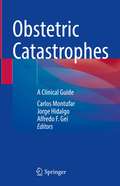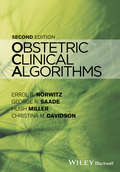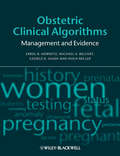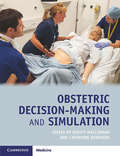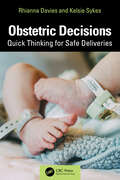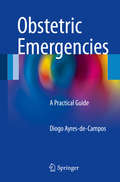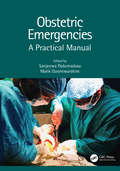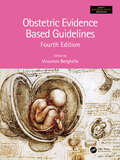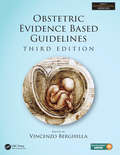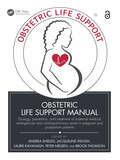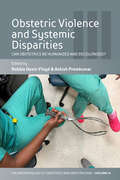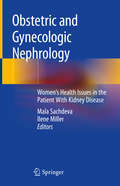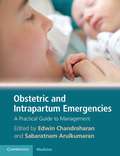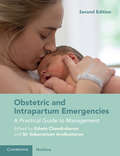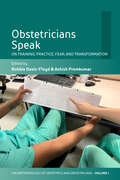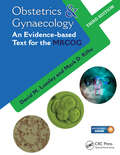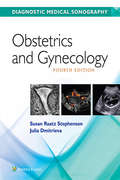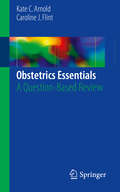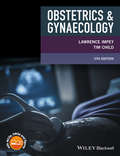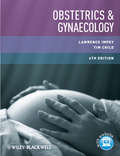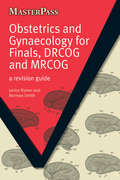- Table View
- List View
Obstetric Anesthesia for Co-morbid Conditions
by Berrin Gunaydin Samina IsmailThis book presents general measures and offers a comprehensive overview of anesthetic considerations for specific serious medical problems in pregnant patients, with a focus on the anesthetic management of non-obstetric disorders during pregnancy and pregnancy-induced diseases. Although many books on this topic are available, this unique volume addresses specific disorders that may be encountered in daily obstetric anesthesia practice and discusses in detail serious medical problems during pregnancy. As such it is a valuable tool, providing targeted information particularly on the anesthetic considerations and management of not only non-obstetric diseases during pregnancy but also pregnancy- induced diseases.
Obstetric Anesthesia: A Case-Based and Visual Approach
by Thomas L. ArcherWith 32 engaging and dramatic cases and 174 colorful, insightful and innovative graphics, this book takes a fresh, creative and highly visual approach to the fundamentals of obstetric anesthesia as well as emerging knowledge and three emerging technologies: 1) pre-procedural ultrasound to facilitate neuraxial block placement, 2) point-of-care transthoracic echocardiography to guide maternal resuscitation, and 3) electrical cardiometry to trend maternal cardiac output and avoid fetal hypoxia. Besides discussing the threats to fetal oxygenation presented by labor and the avoidance of maternal and fetal complications while providing excellent anesthesia, the book also explores the psychological and behavioral dimensions of obstetric anesthesia practice and promotes the obstetric anesthesiologist as a valued member of the obstetric care team who makes unique, insightful and empathic contributions to the overall excellent care of pregnant patients. Obstetric Anesthesia: A Case-Based and Visual Approach is an indispensable resource for medical students, residents, fellows, anesthesiologists, nurse anesthetists, nurse midwives, and obstetricians.
Obstetric Anesthesiology: A Case-Based Approach
by Scott Segal Tauqeer Husain Roshan FernandoThe complex healthcare needs of pregnant patients, where care is tailored to not one but two patients, pose specific challenges to anesthesiologists. This book provides concise, case-based discussion on the clinical scenarios and challenges faced in the provision of anesthesia and pain relief for expectant mothers. In the style of problem-based learning, each case is presented as a short scenario, followed by discussion of the causes, risk factors, management and controversies involved. The textbook features a wide range of cases, from common clinical scenarios that are experienced in day-to-day practice to the rare but significant pathologies less familiar to most clinicians. With a global base of contributors, the book is relevant to practice across the world. The concise format supports both trainee anesthesiologists in their initial experiences of obstetrics and exam preparation, and experienced clinicians in need of a reliable, quick-reference text.
Obstetric Care
by Martin OlsenGain a critical understanding of obstetrics, and a thorough knowledge base of modern management techniques, with this accessible textbook. While acting as a stand-alone text on obstetric care, this volume also forms part of a three-volume set - all authored by leading authorities - on the entirety of obstetric and gynecologic practice. Obstetric Care's topics are based on academic objectives of experts in the field. This textbook offers tailored support for new residents and experienced physicians alike. Obstetric Care is invaluable for wide-ranging yet concise reference material, and provides evidence based care recommendations for specific patient conditions. The chapters in this textbook are based on the objectives of the Committee for Resident Education in Obstetrics and Gynecology; the book offers outstanding modern management techniques across the obstetrics specialty, making it a go-to for reference and comprehensive study.
Obstetric Catastrophes: A Clinical Guide
by Jorge Hidalgo Carlos Montufar Alfredo F. GeiThis book provides a comprehensive overview of critical care obstetrics. The text reviews different diseases and complications that can cause a pregnant patient to go into critical condition, while outlining treatment and management strategies for effective patient care. Critical scenarios covered include obstetric hemorrhage, pulmonary edema in preeclampsia, cardiac arrest, septic shock, abdominal hypertension, uterine rupture, and acute renal failure. Written by experts in the field, Obstetric Catastrophes: A Clinical Guide is a valuable resource for critical care intensivists, obstetricians, and any practitioners involved in the treatment and management of the obstetric patient in critical condition.
Obstetric Clinical Algorithms
by Errol R. NorwitzClinical management algorithms for common and unusual obstetric problems have been developed to help guide practitioners to the best treatment options for patients. In this quick-reference guide, clear diagrams and concise notes show treatment options and evidence for over 80 high-risk obstetric complications, presented in two-page full color spreads to promote quick decision making in time-pressed situations. This new edition includes sections on obesity, late-preterm and early term delivery, and pregnancy termination. As a clinical manual, the book provides guidance to many common and less common obstetric situations in which either the mother or her fetus is at risk. An algorithm for each situation provides obstetric care providers with a step-by-step guide of necessary actions for any given clinical case.Written by internationally renowned experts, Clinical Obstetric Algorithms enables all obstetrics care providers to ensure delivery of a healthy mother and a healthy baby.
Obstetric Clinical Algorithms: Management and Evidence
by Errol R. Norwitz George R. Saade Michael A. Belfort Hugh MillerThe evidence relating to the advances in obstetric practice and research over the past several decades have resulted in significant improvements in maternal and perinatal outcome. The obstetric care provider has the responsibility to be aware of these improvements and implement evidence-based practice when the situation requires. Clinical decisions should, as much as possible, be evidence based. This requires expertise in retrieving, interpreting, and applying the results of scientific studies and in communicating effectively the risks and benefits of different courses of action to patients. The highly-regarded authors have used easy-to-follow management algorithms presented in a highly visual format to assist rapid decision making; with sections covering: Preventative Health Maternal Disorders Infectious Complications Antenatal Complications Intrapartum / Postpartum Complications Featuring best obstetric management guidance, based on graded published evidence and recommendations, this book will enable practicing and trainee obstetrician-gynecologists and nurse midwives to ensure that the primary goals of the delivery of a healthy mother and a healthy baby are met.
Obstetric Decision-Making and Simulation
by Catherine Robinson Kirsty MacLennanSimulation is becoming an integral part of medical education and has already a well-established role within anaesthesia training, with many examination questions already modelled on simulation scenarios. The clinical diversity and multidisciplinary nature of an obstetric team creates the ideal environment for simulation training. It enables the team to develop their knowledge of clinical emergencies whilst becoming more aware of the importance of human factors. This book is a practical guide to inspire clinical leads to establish simulation within their delivery suite. The book comprises an extensive obstetric scenario library, with each scenario broken down into learning outcomes, a list of staff and equipment needed, specific stages mapped to learning outcomes with appropriate results/investigations and a checklist of ideal actions to enable the post-scenario debrief. Written by consultant obstetric anaesthetists, this book will appeal to medical practitioners interested in facilitating obstetric simulation.
Obstetric Decisions: Quick Thinking for Safe Deliveries
by Rhianna Davies Kelsie SykesThis is a practical manual on troubleshooting options when there are obstetric complications, so medical staff can check quickly and easily on the essential points they need to know, do, and recommend.Key Features: Offers a quick and easy-to-consult reference for essential points Presents an invaluable guide for those in training who need to make a decision in complicated circumstances Summarises its points in boxes, flow-charts, and tables
Obstetric Emergencies
by Diogo Ayres-de-CamposThis book will serve as a pocket guide, offering rapid advice on appropriate emergency care for a wide range of obstetric situations, including acute fetal hypoxia, uterine rupture, shoulder dystocia, eclampsia, amniotic fluid embolism, pulmonary thromboembolism, retention of the aftercoming head, major postpartum hemorrhage, and uterine inversion. For each emergency, the definition, diagnosis, and recommended management strategy are reviewed from a pan-European perspective. Regular review and training in obstetric emergencies is the only effective way to develop and maintain clinical competence in these rare and life-threatening situations, thus improving their management and the resulting outcomes. Healthcare professionals will find this book offers a practical and reliable source of information for dealing with dangerous and acute complications of pregnancy and childbirth.
Obstetric Emergencies: A Practical Manual
by Sanjeewa PadumadasaThis is an ideal evidence based clinical guide to the essential principles and practical points arising from obstetric emergencies for residents, trainees, and obstetricians in practice. The concise text, illustrated with key diagrams, is from experienced educators and practitioners.*Provides a concise illustrated guide to the key principles and practical points involved *Gives trainees, residents, and obstetricians the practical information they need in an emergency *Supplies quick and easy reference to key points with illustrations
Obstetric Evidence Based Guidelines
by Vincenzo BerghellaThis new edition of an acclaimed text reviews the evidence for best practice in obstetrics to present the reader with the right information, with appropriate use of proven interventions and avoidance of ineffectual or harmful ones. The information is presented in the right format by summarizing evidence succinctly and clearly in tables and algorithms. The aim is to inform the clinician, to reduce errors, and "to make it easy to do it right." The volume can be purchased separately or together with the companion volume on Maternal-Fetal Evidence Based Guidelines (set ISBN 9780367567033). The Series in Maternal-Fetal Medicine is published in conjunction with the Journal of Maternal-Fetal and Neonatal Medicine. From reviews of previous editions: Obstetric Evidence Based Guidelines is a text that will prove useful to residents and fellows as well as to practicing obstetric clinicians. Furthermore, it can be used as a source for the development of hospital policies for the management of these obstetric problems ... The major advantage of this text is that it provides guidelines for the management of commonly encountered obstetric issues in a single book. —JAMA This is a welcome addition to a physician’s library. Its use of current studies and easy-to-read format allow for easy fact-checking and referencing. —Doody’s Review Service
Obstetric Evidence Based Guidelines (Series In Maternal Fetal Medicine)
by Vincenzo BerghellaThis new edition of an acclaimed text reviews the evidence for best practice in obstetric medicine, to present the reader with the right information, with appropriate use of proven interventions and avoidance of ineffectual or harmful ones, and by rating the evidence of the key references. The information is presented in the right format by summarizing evidence succinctly and clearly in tables and algorithms. The aim is to inform the clinician, to reduce errors and "to make it easy to do it right."
Obstetric Life Support Manual: Etiology, prevention, and treatment of maternal medical emergencies and cardiopulmonary arrest in pregnant and postpartum patients
by Peter Nielsen Andrea Shields Jacqueline Vidosh Laurie Kavanagh Brook ThomsonThis text is a comprehensive review in normal and abnormal pregnancy physiology, the most common etiologies of maternal medical emergencies, recognition of maternal deterioration and pending cardiopulmonary arrest, modifications to cardiopulmonary resuscitation in pregnant and postpartum patients, special procedures that can assist in diagnosing and treating maternal medical emergencies tailored to the setting (e.g., point-of-care ultrasound, resuscitative cesarean delivery, extracorporeal cardiopulmonary resuscitation), treatment of trauma/stroke in pregnancy, and postpartum maternal medical emergencies. There are streamlined algorithms and cognitive aids designed to improve a team’s ability to successfully implement techniques unique to treating maternal medical emergencies and cardiac arrest. Offers a practical guide to treating complex and challenging maternal medical emergencies Equips the entire team responding to a maternal cardiac arrest with the current evidence-based approaches and techniques Presents a thorough review, detailed algorithms, and a consolidated discussion of the practical aspects of implementation The Open Access version of this book, available at http://www.taylorfrancis.com, has been made available under a Creative Commons [Attribution-Non Commercial-No Derivatives (CC-BY-NC-ND)] 4.0 license.
Obstetric Violence and Systemic Disparities: Can Obstetrics Be Humanized and Decolonized? (The Anthropology of Obstetrics and Obstetricians: The Practice, Maintenance, and Reproduction of a Biomedical Profession #3)
by Robbie Davis-Floyd and Ashish PremkumarThe final volume in this landmark 3-volume series The Anthropology of Obstetrics and Obstetricians: The Practice, Maintenance, and Reproduction of a Biomedical Profession looks at the challenges, and even violence, that obstetricians face across the world. Part I of this volume addresses obstetric violence and systemic racial, ethnic, gendered, and socio-structural disparities in obstetricians’ practices in the Dominican Republic, Mexico, Peru, and the US. Part II addresses decolonizing and humanizing obstetric training and practice in the UK, Russia, Brazil, New Zealand, and the US. Part 3 presents the ethnographic challenges that the chapter authors in Volumes II and III of this series faced in finding, surveying, interviewing, and observing obstetricians in various countries. This book is a must-read for students, social scientists, and all maternity care practitioners who seek to understand the diverse challenges that obstetricians must overcome. An excerpt: In our Series Overview in Volume 1, we asked the question, “Can a book create a field?” and answered that question with a resounding “Yes!” … For us, the official creation of the field of the Anthropology of Obstetrics and Obstetricians has taken not one, but the 3 volumes that constitute this Book Series.
Obstetric and Gynecologic Nephrology: Women’s Health Issues in the Patient With Kidney Disease
by Mala Sachdeva Ilene MillerThe female patient with chronic kidney disease often requires care that differs from the male patient. Particularly in the pregnant patient, a specialized body of knowledge is required to provide optimal care. This book focuses on such issues encountered during pregnancy including physiology and pathophysiology of pregnancy, hypertension, preeclampsia, various electrolyte disorders, nephrolithiasis, pharmacological management in the pregnant patient with kidney disease and during breastfeeding, acute kidney and chronic kidney disease, dialysis of the pregnant patient, lupus nephritis, thrombotic microangiopathy, glomerular disease management, use of renal biopsy during pregnancy, care of the female transplant patient, contraceptive counseling and postpartum care, various endocrine disorders, and bone disease in the female patient with chronic kidney disease. This book features the latest evidence and clinical approaches for the beginner or for the experienced practitioners who care for pregnant woman or even for those who require expertise in women’s health.Written by experts in the field, Obstetric and Gynecologic Nephrology: Women’s Health Issues in the Patient with Kidney Disease is a valuable resource for clinicians and practitioners involved in the care and treatment of obstetric and gynecologic patients afflicted with kidney disease.
Obstetric and Intrapartum Emergencies
by Sabaratnam Arulkumaran Edwin ChandraharanEvery day, approximately 1000 women die from preventable causes related to pregnancy and childbirth, most of which result from common treatable complications, such as haemorrhage, infections, pre-eclampsia and obstructed labour, which have not been recognized in time or treated properly. Every unborn child also faces risk of stillbirth, birth trauma, oxygen deprivation and neonatal death or long-term brain damage during birthing. Obstetric and Intrapartum Emergencies: A Practical Guide to Management is written by a wide variety of obstetric experts in developing and developed countries and provides an easy-to-use guide to recognize and treat perinatal emergencies before it is too late. The text includes learning tools such as 'Key Pearls' and 'Key Pitfalls', a section on managing emergencies in a low-resource setting and contains detailed illustrations throughout. This book is a practical and invaluable guide for obstetricians, neonatologists, midwives, medical students and the wider perinatal team.
Obstetric and Intrapartum Emergencies: A Practical Guide to Management
by Sabaratnam Arulkumaran Edwin ChandraharanGlobal and national confidential inquiry reports show that 60 to 80% of maternal and neonatal morbidity and mortality are due to avoidable errors. This comprehensive and illustrated second edition offers a practical guide to the management of obstetric, medical, surgical, anaesthetic and newborn emergencies in addition to organisational and training issues. The book is divided conveniently into nine sections and updated throughout in line with modern research and practice. Several new chapters cover setting up skills and drills training in maternity services to reduce avoidable harm, managing obstetric emergencies during 'home births' and in low-risk midwifery units, and minimizing maternal and fetal morbidity in failed operative vaginal delivery. Each chapter includes a practical algorithm for quick reference, the scientific basis for proposed actions, a case-based practical exercise and useful learning tools such as 'Key Pearls' and 'Key Pitfalls'. An invaluable resource for obstetricians, neonatologists, midwives, medical students, anesthesiologists and the wider perinatal team.
Obstetricians Speak: On Training, Practice, Fear, and Transformation (The Anthropology of Obstetrics and Obstetricians: The Practice, Maintenance, and Reproduction of a Biomedical Profession #1)
by Robbie Davis-Floyd and Ashish PremkumarFor the first time ever in a social science work, obstetricians tell their own stories of training, practice, fear, and transformation in this the first of the 3-volume series The Anthropology of Obstetrics and Obstetricians: The Practice, Maintenance, and Reproduction of a Biomedical Profession. These stories range from those of abortion providers to those of maternal-fetal medicine specialists. Several chapters tell the stories of obstetricians who have made paradigm shifts from technocratic to humanistic practices, the benefits and joys of these paradigm shifts, and the ostracism, bullying, and outright persecution these humanistic obstetricians have suffered. This book is a must-read for students, social scientists, and all maternity care practitioners who seek to understand the ideologies and motives of individual obstetricians. An excerpt from Kathleen Hanlon-Lundberg’s chapter: Largely maligned in reproductive anthropological literature as callous—if not brutal—self-serving effectors of the over-medicalization of childbirth, most obstetricians whom I know and have worked with are devoted to providing respectful, individualized care to their patients.
Obstetrics & Gynaecology: An Evidence-based Text for MRCOG, Third Edition
by Mark D. Kilby David M. LuesleyModelled after the current MRCOG curriculum, the new edition of this bestselling book provides all the information a specialist registrar in obstetrics and gynaecology or senior house officer needs during training or when preparing for the MRCOG examination. Obstetrics & Gynaecology: An Evidence-based Text for MRCOG covers the latest profession
Obstetrics & Gynecology: A Guide To Clinical Practice, Obstetrics And Gynecology (Diagnostic Medical Sonography Series)
by Susan Stephenson Julia DmitrievaThe updated Diagnostic Medical Sonography Series, which includes new editions of Diagnostic Medical Sonography: Abdomen and Superficial Structures, Diagnostic Medical Sonography: Obstetrics and Gynecology, and Diagnostic Medical Sonography: The Vascular System, provides the right content at the right level for the right way to teach and learn. The updated 4th Edition of Stephenson’s Diagnostic Medical Sonography: Obstetrics and Gynecology offers the most in-depth, current, and consistent coverage of this crucial sonography topic available today.
Obstetrics Essentials
by Kate C. Arnold Caroline J. FlintThis book is a compact question-based review of the most critical topics an obstetrician will come across in practice. Each chapter includes 10-30 multiple-choice questions designed to test the readers understanding surrounding one obstetric topic. Based on all 45 obstetric based practice bulletins by ACOG, this text is designed to keep practitioners up-to-date with the latest evidence based medicine. Sample topics include: anemia in pregnancy, screening for fetal chromosomal abnormalities, and vaginal birth after previous cesarean delivery. This is an ideal tool for attendings and clerkship directors who frequently test residents and medical students during rounds and in the classroom. This review also proves useful for practicing physicians and physicians-in-training who want to self-evaluate their comprehension and study for board examinations.
Obstetrics and Gynaecology
by Lawrence Impey Tim ChildObstetrics & Gynaecology has established itself as a key recommendation for faculty and a firm favourite for health sciences students.The opening sections of this new edition incorporate the relevant basic science, history and examination, investigations and diagnosis, as well as common diseases, abnormalities, and complications in gynaecology and obstetrics respectively. These are supported by two unique sections on gynaecology and obstetrics management, which are tailored to help students revise for exams, especially OSCEs. A brand new chapter covering ethics in obstetrics and gynaecology makes this fully-updated fourth edition the most comprehensive introduction available.Obstetrics & Gynaecology now includes a companion website at www.impeyobgyn.com, featuring self-assessment MCQs and EMQs, chapter summary slides, and all the figures from the book as PowerPoint slides.
Obstetrics and Gynaecology (Oxford Medical Handbooks Ser.)
by Lawrence Impey Tim ChildObstetrics & Gynaecology has established itself as a key recommendation for faculty and a firm favourite for health sciences students. The opening sections of this new edition incorporate the relevant basic science, history and examination, investigations and diagnosis, as well as common diseases, abnormalities, and complications in gynaecology and obstetrics respectively. These are supported by two unique sections on gynaecology and obstetrics management, which are tailored to help students revise for exams, especially OSCEs. A brand new chapter covering ethics in obstetrics and gynaecology makes this fully-updated fourth edition the most comprehensive introduction available. Obstetrics & Gynaecology now includes a companion website at www.impeyobgyn.com, featuring self-assessment MCQs and EMQs, chapter summary slides, and all the figures from the book as PowerPoint slides.
Obstetrics and Gynaecology for Finals, DRCOG and MRCOG: A Revision Guide (MasterPass)
by Norman Smith Janice RymerThis examination and revision guide comprehensively tests knowledge at all levels in obstetrics and gynaecology. The wide-ranging sample questions have detailed answers to provide proper explanation and aid understanding, and the variety of question formats prepares students for all possibilities in the examination. The best of five question format is ideal for DRCOG candidates, the EMQs prepare the MRCOG candidates, and the MCQs will test both DRCOG and MRCOG candidates. The book is also highly recommended for undergraduates preparing for their finals, who will welcome the sample best of fives and EMQs now that essays and short answer questions are becoming a thing of the past.
